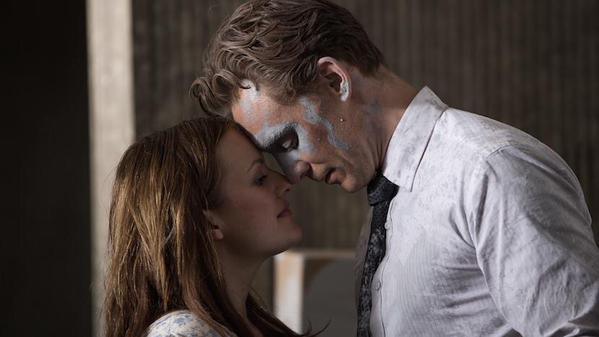The story of a high-tech apartment block slowly falling apart under the weight of shoddy workmanship and crumbling expectations? Critics won’t find a more apt metaphor for reviewing High-Rise than the one supplied by the film itself.
Going through Ben Wheatley’s High-Rise is like a journey though a 40-storey tower block, only in reverse, starting at the top. The plush penthouse is furnished and decorated sumptuously, but it’s only as we work our way down through the structure that the cracks begin to appear. The solid foundation on which all this is built is J.G. Ballard’s 1975 novel, a typically sharp satire on the manipulative effect of modern lifestyles. The various classes and cliques of an ultra-modern apartment block turn on one another in an orgiastic venting of primal urges. Based on that pitch alone, it’s clear that an adaptation was going to be difficult. It needed to be lurid yet sharp, a balance of which few directors would seem capable. When the project was announced, the fact that it was coming from the director of such violently esoteric works as Kill List and A Field In England was comforting. Perhaps this would do justice to the Ballard’s vision, a vision that producer Jeremy Thomas had tried to bring to cinematic life since the novel was first published. This structure is burdened with high hopes.
The first scene suggests success. The film opens, as does the novel, with Dr. Robert Laing (Tom Hiddleston) tucking into the hind leg of a dog. His apartment bears the marks of a long descent from stress-free living into anarchy. Laing, a resident of the 25th floor, is our guide through the morass of a building that was to be a beacon of civilization, as per the designs of architect/penthouse resident Anthony Royal (Jeremy Irons). Irons’ presence (Cast Irons? There’s a gag there somewhere…) and Ballard’s text can’t but evoke allusions to David Cronenberg. Alas, the comparisons do High-Rise few favours. Cronenberg made his own high-rise horror, Shivers, the same year that Ballard’s novel was released. Its vision of a tower block tearing itself apart in a frenzy is barmy fun, but not a lot has changed in the stakes of localized anarchy. Its polished surfaces and gleaming swimming pools can be seen in High-Rise, albeit as much a result of coincidence as influence, but it goes to show that the thematic richness of the novel may have been milked long before now. As if to hammer home the point, Amy Jump’s script locates the action in the late 1970s. This decision allows DoP Laurie Rose and production designer Mark Tildesley to show off their skills. The garish world of shag carpets and yellow kitchen panelling is illuminated by narrow windows and round-funneled lamps. It’s pitch-perfect design for the period, but the 1970s stylings insist on themselves to such an extent that any possibility of modern relevance is smothered in furs.
The greater, and more damaging, Cronenberg-Ballard connection is Crash. The Canadian auteur’s symphorophilic thriller is definitively jet-black, even darker than Ballard’s 1973 tome on which it’s based. The fact the film was made was impressive enough, but then there’s little that compares to Crash in its narrative or its transgressions. Ballard’s eerie architectural detachment can be seen in the works of many artists, from Bret Easton Ellis to David Fincher. The aggressiveness of Wheatley’s earlier works, Down Terrace and Kill List, suggest he could at least grapple with the savagery of High-Rise’s source novel. There’s no lack of bloodshed, but it all happens within an over-designed setting that has little purpose other than to call attention to itself. The affectations of High-Rise, whether the period setting, choppy acting or wandering narrative, deny the film the muscularity it needs to carry home any convincing themes. An early scene sees Dr. Laing giving his medical students a lecture on dissection. As he digs into a cranium, he cartoonishly peels off the face to reveal the skull’s structure. Tonally, this feels far closer to Wheatley’s comic sojourn Sightseers than it ever does to Kill List. The metaphors are there, but High-Rise feels too comic when it should deliver a killer blow.
As Laing, Hiddleston is our way into this complex full of complexes, but he’s perhaps a little too polished and chipper, lacking the menace to sell Laing as just another mind about to succumb to the ego. More watchable are Irons’ hammy omnipotence and Sienna Miller’s unchecked vampishness as Laing’s neighbour/lover Charlotte. The tower block is full of actors with potential, but the potential is only realised on occassion; for every solid Elisabeth Moss, there’s a hammy James Purefoy lurking nearby. The cast’s MVP is Luke Evans, delivering a star turn as Wilder, a lower-dwelling resident and documentarian determined to investigate why the tower’s residents are turning on each other. It’s apt that Evans’ performance is the strongest here; his character is the one in search of the truth, but his eventual failure in that regard is also the failure of High-Rise. There’s never any sense that there’s any good reason architecturally, psychologically or financially for Royal’s sky-high experiment to fail. The second act of the film feels less like a narrative and more like a long montage of power failures, fighting and looting. It all goes on so long that the third act rolls in like an inert piece of fast food, undigested and blatantly artificial. Ballard’s novel brought smarts and shocks; Wheatley barely manages the latter. By the time the voice of Margaret Thatcher crackles on the soundtrack before the credits roll, it’s become clear that High-Rise is stuck in a time warp. That might be a great cue for Portishead to deliver an oddly moving take on ABBA’s ‘S.O.S.’, but it’s not enough of a hook on which to hang a Ballard adaptation. The lights are on, but this block’s been long since vacated.

